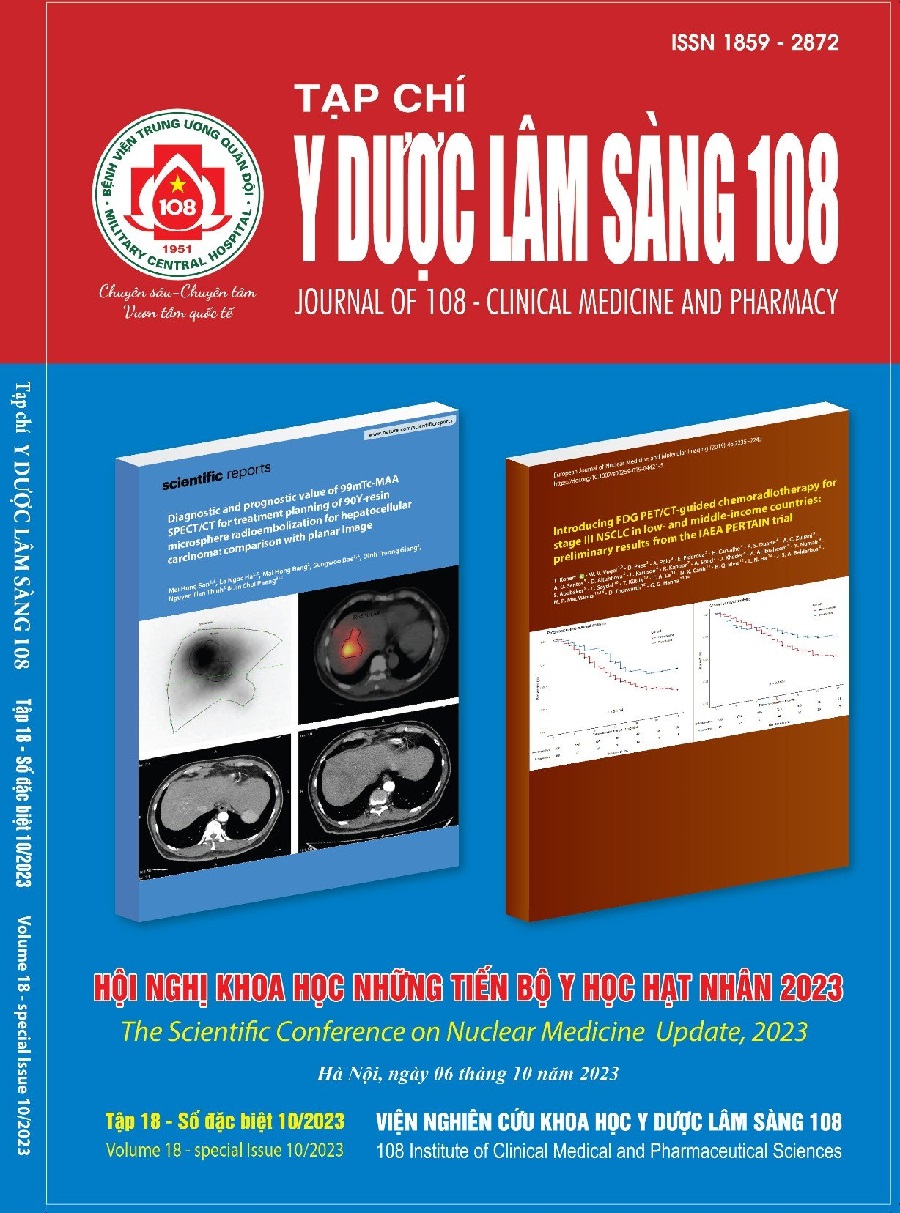Characteristics of FDG PET/CT in treated hepatocellular carcinoma with high levels of PIVKA-II or AFP-L3
Main Article Content
Keywords
Abstract
Objective: Many diagnostic imaging modalities are used in follow-up of treated hepatocellular carcinoma (HCC). The aim of this study is to investigate characteristics of FDG PET/CT in follow-up of treated HCC with elevated levels of PIVKA-II or AFP-L3. Subject and method: A retrospective study analyzed treated HCC patients who had PIVKA-II > 40mAU/ml or AFP-L3 > 10% and underwent FDG PET/CT with dynamic CT. We investigated PET/CT imaging characteristics in correlation with serum PIVKA-II and AFP-L3. Result: FDG PET/CT detected lesions in 42 of 48 patients (87.5%), including hepatic lesions in 16 (33.3%), extrahepatic lesions in 10 (20.8%) and both in 16 patients (33.3%). 26 of 48 patients (54.2%) had extrahepatic lesions: Lung (31.2%), distal lymph node (16.6%), peritoneum (8.3%), regional lymph node (6.2%), bone (6.2%) and adrenal gland (2.1%). Mean AFP-L3 value was 40.6% in group of patients with lesions in PET/CT and 11.7% in patients without lesions (p=0.02). There was no difference on PIVKA-II value between both groups. Conclusion: In patients with treated HCC with high serum concentration of PIVKA-II or AFP-L3, FDG PET/CT played an important role in detection of lesions. The indication for FDG PET/CT should be considered when negative conventional imaging or to further evaluate and find out further lesions.
Article Details
References
2. Chen Z, Liang H, Zhang X et al (2012) Value of (18)F-FDG PET/CT and CECT in detecting postoperative recurrence and extrahepatic metastasis of hepatocellular carcinoma in patients with elevated serum alpha-fetoprotein]. Nan Fang Yi Ke Da Xue Xue Bao 32(11): 1615-1619.
3. Izuishi K, Yamamoto Y, Mori H et al (2014) Molecular mechanisms of [18F] fluorodeoxyglucose accumulation in liver cancer. Oncol Rep 31(2): 701-706.
4. Katyal S, Oliver JH, Peterson MS et al (2000) Extrahepatic metastases of hepatocellular carcinoma. Radiology 216(3): 698-703.
5. Kim DY, Paik YH, Ahn SH et al (2007) PIVKA-II is a useful tumor marker for recurrent hepatocellular carcinoma after surgical resection. Oncology 72(1): 52-57.
6. Park SJ, Jang JY, Jeong SW et al (2017) Usefulness of AFP, AFP-L3, and PIVKA-II, and their combinations in diagnosing hepatocellular carcinoma. Medicine (Baltimore) 96(11): 5811.
7. Shawky Elsawabi A, Abdel wahab K, Ibrahim W et al (2019) α-Fetoprotein (AFP)-L3% and transforming growth factor B1 (TGFB1) in prognosis of hepatocellular carcinoma after radiofrequency. Egypt Liver Journal 9, 8.
8. Globocan (2020). https://gco.iarc.fr/today/data/ factsheets/populations/704-viet-nam-fact-sheets.pdf.
9. Yamamoto K, Imamura H, Matsuyama Y et al (2010) AFP, AFP-L3, DCP, and GP73 as markers for monitoring treatment response and recurrence and as surrogate markers of clinicopathological variables of HCC. J Gastroenterol 45(12): 1272-1282.
10. Yip VS, Gomez D, Tan CY et al (2013) Tumour size and differentiation predict survival after liver resection for hepatocellular carcinoma arising from non-cirrhotic and non-fibrotic liver: A case-controlled study. Int J Surg 11(10): 1078-1082.
11. Yu R, Tan Z, Xiang X et al (2017) Effectiveness of PIVKA-II in the detection of hepatocellular carcinoma based on real-world clinical data. BMC Cancer 17(1): 608.
 ISSN: 1859 - 2872
ISSN: 1859 - 2872
